Home
Camera
Articles FOR SALE
Orders
I Buy / Wants Repairs
Books Adapters
Miranda Orion
The Miranda Orion is one of the rarest of 35mm SLRs,
and one of the most historically significant. This 1956 camera was the
first Japanese SLR to use a pentaprism. The Orion was the product of the Orion Seiki
Company, founded by the brilliant and innovative Mr. Akira Ogihara. His genius
brought forth three notable products which cast a long shadow of influence over the
Japanese camera industry.
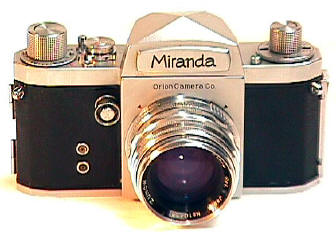
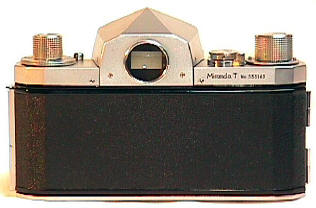
The famous superbly made Orion adapter,
available for either Contax Rangefinder lenses or Nikon Rangefinder lenses,
allowed their use WITH rangefinder coupling on Leica screw mount
cameras. See Separate Profile. Once word got
out, demand exceeded production. That is still true today, with collectors avidly
seeking them. I was lucky enough to get one literally for free--it was at the
bottom of a camera bag and was not even figured into the value of an outfit I bought.
Orion's Mirax Reflex housing, converted
Leica, Contax and Nikon rangefinder cameras to single lens reflexes for longer than 135
lenses (similar to the Leica Visoflex). It foreshadowed the later Miranda's
great versatility by using interchangeable adapters for different cameras.
Perhaps most importantly, it had an optional pentaprism.
Orion's entry into the SLR market was ready by the
end of 1956, the famous Miranda Orion. The first few hand made
prototypes were called the Phoenix. Due to trade mark restrictions with a
German camera, the Phoenix was renamed Miranda. The first model was the
Miranda T, but the first T's also had the "Orion Camera Company" on the
front nameplate, below the Miranda name. Thus the "Miranda
Orion." Hand made at the blistering rate of about 50 per month, the first
Miranda sallied forth to change the photographic world.
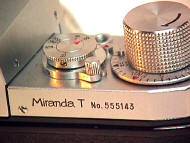 Orion Serial #'s: I suspect the serial
number may indicate a starting date, such as used on the first
Nikons. Nippon Kogaku started the serial numbers of their new
"Nikon" camera with 609x, signifying September of
1946. The earliest Orions I know of are in the 554xxx range.
The starting 554 sequence may indicate April of 1955. That would make
the probable starting Orion serial number 554001. I admit I'm
guessing, if anyone has more accurate info, please contact me. On the
other hand, 554 may commemorate the five famous camera assemblers who could down 5
saki drinks in four seconds -- who knows ??
Orion Serial #'s: I suspect the serial
number may indicate a starting date, such as used on the first
Nikons. Nippon Kogaku started the serial numbers of their new
"Nikon" camera with 609x, signifying September of
1946. The earliest Orions I know of are in the 554xxx range.
The starting 554 sequence may indicate April of 1955. That would make
the probable starting Orion serial number 554001. I admit I'm
guessing, if anyone has more accurate info, please contact me. On the
other hand, 554 may commemorate the five famous camera assemblers who could down 5
saki drinks in four seconds -- who knows ??
Miranda Orion Firsts and Influence, the Orion exerted quite an influence:
- First Japanese production SLR with Pentaprism
- First Japanese SLR with
interchangeable prism or waist level finders
- First Japanese SLR with a
finder which slides into mounting grooves. This secure
mounting method was later used on all later Mirandas, the Topcon Super D, Canon F-1,
Nikon F4, and F5. The Nikon F and F2 used a less secure latch and lift off
method, more similar to the Exakta.
- First Japanese small bodied
SLR with Pentaprism. Its influence was followed by
Pentax screw mount cameras, and much later by the Olympus OM and their imitators.
- The Orion was quiet, and
especially valued by Leica photogs switching to SLRs.
- Established the Miranda lens mount which lasted to the last Miranda, the DX-3. Though the mount was
later modified so far as meter coupling and auto diaphragms were concerned, the camera
mount itself stayed the same.
- Established the Miranda tradition of versatility. With adapters and a relatively thin body, Mirandas
could mount more lenses than any other SLR of their time: Exakta, Praktica or Pentax
screw mount, and Miranda. Adapters were also made for Leica screw mount, Nikon and
Contax Rangefinder mounts -- though these RF lenses would not focus to infinity.
A later adapter allowed the mounting of Nikon F lenses too.
- Established Miranda tradition of front mounted shutter
release. The theory is a front mounted shutter will
generate less vibration than a top mounted release. More importantly, it
allowed the use of automatic Exakta lenses with the Miranda Exakta adapter. OK, so
they would be upside down with the adapter, but they worked!!
- A few black Orions were made,
probably making the Orion the first Japanese 35 SLR available in black, though it must
have been special order.
- Total production very
limited, probably less than 1000 before "Orion" was replaced by
"Miranda."
Orion Features:
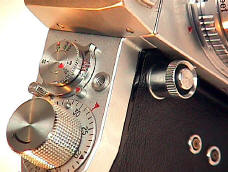
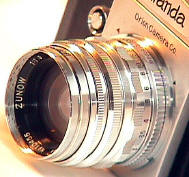
- Knob wind film advance and film rewind, none of those tricky lever things here.
- Two shutter releases.
One on the front right side of the camera, another on the top plate which could be
unscrewed to uncover a standard cable release socket (shown.) Every Orion I
personally have seen is missing the top mounted shutter release which looks like a small
knurled chrome button. The front mounted release could take a Leica cable
release.
- Manual diaphragm.
What's that? It means the lens aperture is not connected to the camera, so you have
to manually open the lens to focus, and then manually close it down to the selected
aperture to take the shot, and then manually open it up again to focus. You didn't
know you had it so easy.
- The lens has a pre-set
diaphragm. If you look at the lens above, you will see
three knurled rings. The closest to the body is the focusing ring. The middle
ring is the pre-set ring. The outermost ring is the aperture ring. The photog
pre-sets the aperture ring, and then can quickly opens or closes the pre-set ring to the
pre-selected aperture by feel -- the pre-set ring can only move to the pre-selected
aperture and not beyond. The pre-set diaphragm was looked upon as a
major advance over the earlier aperture ring, which could easily be set to the wrong
aperture by the fast working photog.
- Unusual for Miranda, the Zunow
is a SCREW MOUNT lens which uses the interior lens mount
rather than the outer bayonet mount. Most of the early Miranda lenses used the
internal screw mount.
- No instant return mirror.
After each exposure, the finder remained dark until you advanced the film which also
lowered the mirror into place. This is the same system used on all early SLRs, until
Asahi invented the instant return mirror which would automatically spring back into place.
- The viewfinder has plain
ground glass focusing, without any focusing aid including a
fresnell screen.
- No built in meter. My
god, you had to figure out your exposure yourself !! Hopefully you do a better job
than Clinton did with Monica.
- Manual set frame counter. Yep,
you had to set it to 1 on the first exposure, otherwise you will be guessing how many
shots you have left. It's on the dial around the film advance knob.
- The early standard lens was a 50/1.8
Zunow. See separate Zunow Profile.
- The shutter speed dial had
combined low and high speeds on the same shaft, much like the
Nikon S and S2.
- The back opened for easy film loading
- The focusing screens were not user interchangeable.
- Shutter speeds from 1 to
1/500th.
- Standard PC flash contacts
were used for either electronic flash or bulbs.
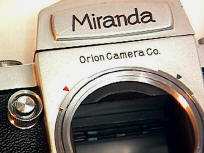
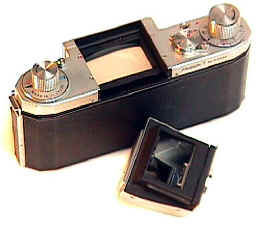
The Orion's features might seem
outdated today, but for 1956, it was on the cutting edge. Just consider what today's Nikon F5 and EOS 1V will look like in 2040--now
that's a depressing thought.
Revised:
November 26, 2003
. Copyright � 1998-2002
Stephen Gandy. All rights reserved. This means you may NOT
copy and re-use the text or the pictures in ANY other internet or printed
publication of ANY kind. Information in this document is subject to change
without notice. Other products and companies referred to herein are
trademarks or registered trademarks of their respective companies or mark
holders.




 Orion Serial #'s: I suspect the serial
number may indicate a starting date, such as used on the first
Nikons. Nippon Kogaku started the serial numbers of their new
"Nikon" camera with 609x, signifying September of
1946. The earliest Orions I know of are in the 554xxx range.
The starting 554 sequence may indicate April of 1955. That would make
the probable starting Orion serial number 554001. I admit I'm
guessing, if anyone has more accurate info, please contact me. On the
other hand, 554 may commemorate the five famous camera assemblers who could down 5
saki drinks in four seconds -- who knows ??
Orion Serial #'s: I suspect the serial
number may indicate a starting date, such as used on the first
Nikons. Nippon Kogaku started the serial numbers of their new
"Nikon" camera with 609x, signifying September of
1946. The earliest Orions I know of are in the 554xxx range.
The starting 554 sequence may indicate April of 1955. That would make
the probable starting Orion serial number 554001. I admit I'm
guessing, if anyone has more accurate info, please contact me. On the
other hand, 554 may commemorate the five famous camera assemblers who could down 5
saki drinks in four seconds -- who knows ?? 


